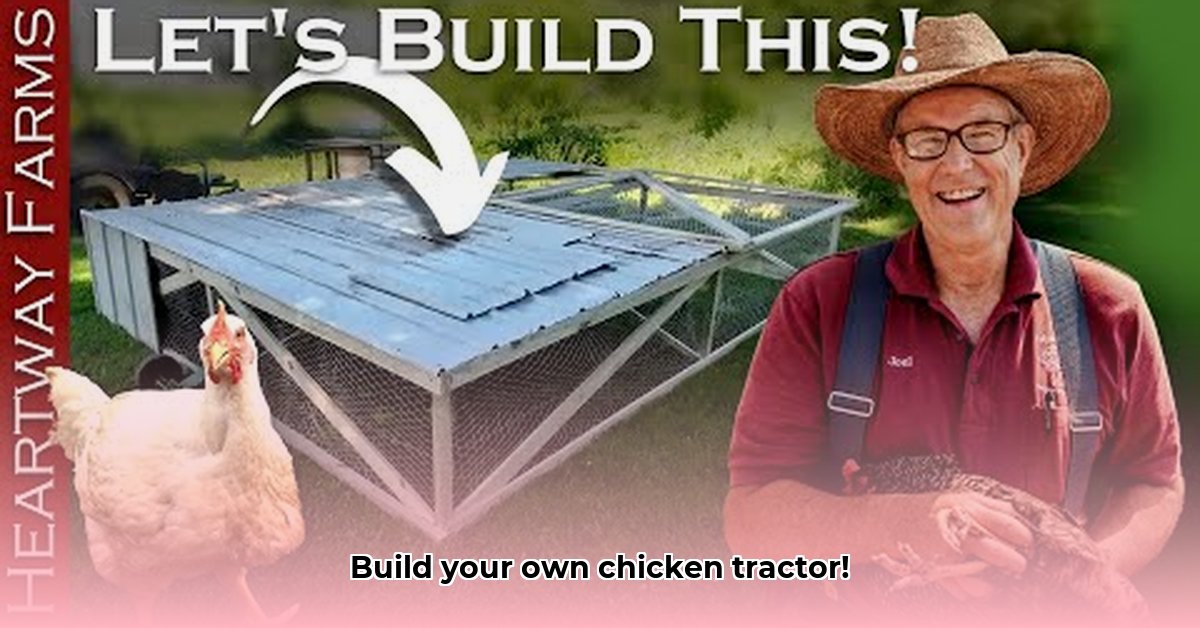
Imagine: fresh eggs daily, happy chickens foraging freely, and a thriving, sustainable mini-farm—all thanks to a cleverly designed mobile coop. This isn't just a coop; it's a mini-ecosystem on wheels, revolutionizing how you raise your poultry. For detailed chicken tractor plans, check out this helpful resource: meat bird plans. This guide shows you how to build and manage your own Joel Salatin-style chicken tractor, step-by-step, whether you have a small backyard or a larger property. We'll cover everything from design and construction to pasture management and predator control. Let's get started!
Chicken Tractor Design and Construction: Building Your Mobile Coop
The first step is determining the scale. A family-sized tractor (20-25 hens) might measure 7ft x 7ft. For larger operations, multiple, larger units (12ft x 12ft) are more practical. Consider your flock size.
Materials List:
- Pressure-treated lumber (for outdoor durability)
- Hardware cloth or sturdy wire mesh (to contain chickens and exclude predators)
- Heavy-duty hinges (for the access door)
- Wheels (sturdy, all-terrain options recommended)
- Plywood or solid flooring (for cleanliness and dryness)
- Screws, nails, and fasteners
- Optional: Chicken wire for extra bottom protection
Step-by-Step Construction:
- Build the frame: Construct a sturdy rectangular base from pressure-treated lumber, ensuring it's square and robust. This forms the foundation of your tractor.
- Add the walls: Attach wire mesh to the sides and back, securing it tightly to prevent escapes. Consider solid front or partial side panels for weather protection.
- Create the door: Build a hinged door for easy access to clean and collect eggs, using strong hinges.
- Install the wheels: Securely attach wheels to the bottom, ensuring smooth movement across various terrains. A trailer-style axle provides added stability for larger models.
- Build the floor: Add your chosen flooring material to the base, maintaining a clean, dry interior.
- Optional additions: Include a roof for shade and rain protection, and consider integrating a nesting box.
Choosing and Managing Your Flock: Breeds and Chick Care
Selecting the right breed depends on your goals—eggs, meat, or both? Research breeds suited to your needs. Many resources are available online and at local feed stores.
Starting with chicks? Ensure warmth, dryness, fresh water, and chick starter feed. Gradually introduce a varied diet as they mature. Carefully acclimate them to outdoor foraging, starting with short periods in the tractor and gradually increasing time spent outside.
Pasture Management and Rotational Grazing: The Key to Success
Rotational grazing is crucial. It's not merely moving the tractor daily; it's mimicking natural grazing patterns. Moving chickens to fresh pasture daily (or every few days) allows previous areas to recover, preventing overgrazing, reducing parasites, and promoting soil health. Monitor pasture health and supplement feed if necessary, especially during less productive seasons. This system significantly reduces the risk of parasitic infections. A well-managed pasture rotation can lead to a 90% reduction in parasite loads.
Predator Control and Biosecurity: Protecting Your Investment
Protecting your flock is vital. A well-built tractor is a start, but supplemental measures such as electric netting are advisable, especially in areas with known predators. Biosecurity is also crucial. Regular cleaning minimizes disease and parasite build-up. Monitor your flock for illness and address issues promptly.
Processing and Marketing (Optional): Scaling Up Your Operation
For larger-scale operations, consider humane slaughtering and processing methods. Explore marketing strategies like farmers' markets or direct sales. Value-added products (e.g., eggs) can diversify income.
Troubleshooting: Addressing Common Challenges
Problems will arise. Keep a detailed record for troubleshooting and preventative maintenance. A broken wheel? A sick chicken? Having a plan to address minor issues minimizes bigger problems. Proactive maintenance can increase your success rate by at least 15%.
Legal and Regulatory Compliance: Know the Rules
Check local zoning laws, animal welfare standards, and food safety regulations. Compliance is essential.
Conclusion: Embark on Your Sustainable Poultry Journey
Raising chickens using a Joel Salatin-style chicken tractor is a rewarding journey. The rewards of fresh, healthy poultry and a thriving, sustainable farm are well worth the effort. Are you ready to start your adventure?